The LG G4 has arrived, complete with a leather back, boosted camera, screen and specifications
Different people want different things from their smartphones. Some place appearance and design above all else. Others want the very fastest performance. A fair chunk, however, value the practical things in life, and it's these people who will be looking closest at the LG G4.
Of all the leading smartphones launched in 2015, the LG G4 is the only one with both a microSD card and a removable battery.
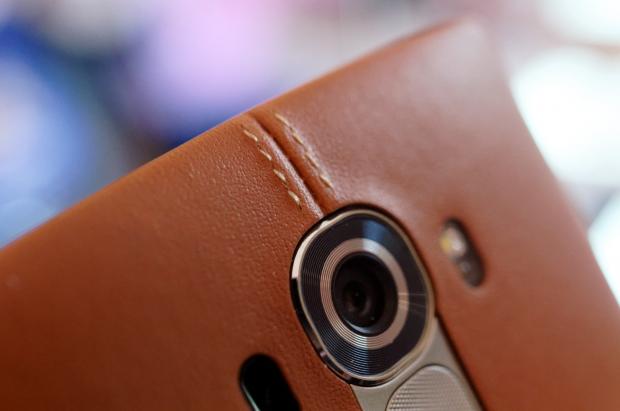
The LG G4’s design, certainly in terms of its basic shape and the placement of the controls, breaks no new ground. The rear is still gently curved and fits in your hand nicely. The volume and power buttons still reside in the centre of the rear panel, just below the camera lens.
lens.
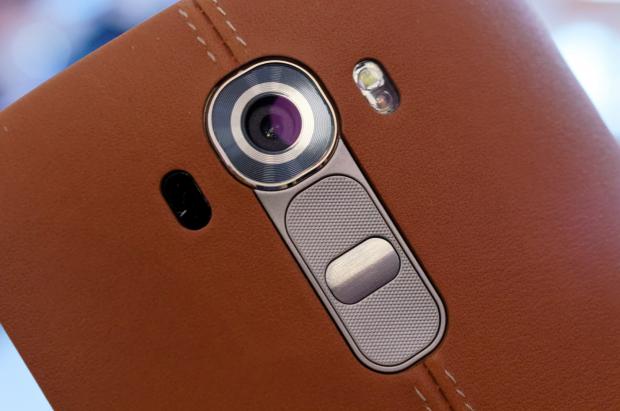
The overall dimensions haven’t changed much either. The LG G4 is slightly taller and slightly wider than the G3 at 149 x 75 x 8.9mm, but these are not differences you’ll notice with the naked eye.
Turn it on its side, however, and the changes begin to reveal themselves. First, the G4 sports a “Slim Arc” screen that gently curves from top to bottom, a bit like LG's G Flex models, but the curve isn’t quite so extreme.
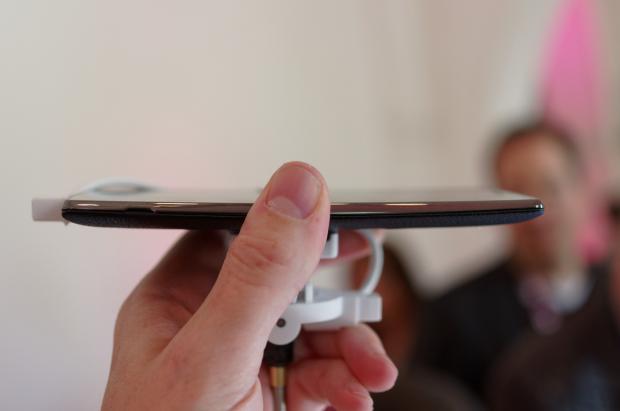
The most dramatic new ‘feature’ introduced by LG, perhaps inspired by the Motorola Moto X (2014), is to the materials used in the design. You will, perhaps, have already seen the brown, leather-backed edition in the teaser material released by the company.
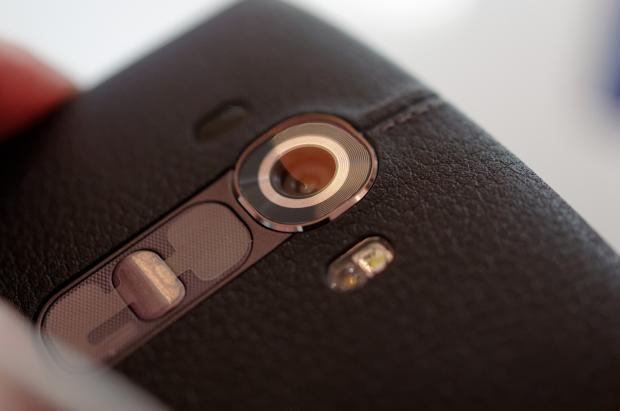
Well, that’s a standard (albeit premium) finish on the G4, and it isn’t just available in brown. There’s a whole range of different colours, all of which look very fetching, with precise, close stitching running down the centre and the G4 logo debossed into the leather in the bottom right corner.
There's even differentiation in the type of leather used, depending on the colour, with a smooth, close-grained briefcase finish on the brown and burgundy versions, and a coarser more open grained leather used on the pale blue, black, and light tan models.
The LG G4 also comes, slightly less interestingly, in plastic in a fetching range of shades including a glossy, "ceramic" white and titanium grey, with a subtle diamond pattern moulded into the shell.
We suspect most people choosing an LG G4 will go for the leather finish, which feels very nice indeed in the hand and looks great; the black version in particular is fabulous.
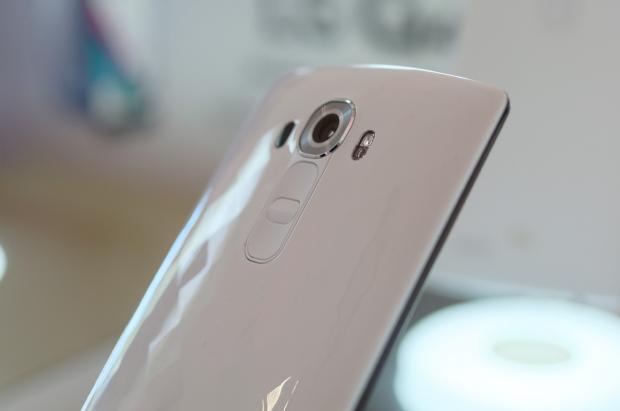
It wouldn't be a flagship launch without a specifications bump, so it's hardly a surprise to see an improvement on that front. But at least LG is doing things differently from the majority of the competition, utilising Qualcomm's six-core, 64-bit 1.8GHz Snapdragon 808 SoC, which is backed by an Adreno 418 GPU, 3GB of RAM and 32GB of storage.
Other specs include dual-band, dual-stream 802.11ac Wi-Fi with support for MU-MIMO, Cat9 4G with download speeds of up to 450Mbits/sec, Bluetooth 4.1 and NFC. What you don't get is any kind of waterproofing or wireless charging as standard, although you can add the latter via an optional replacement back.
with download speeds of up to 450Mbits/sec, Bluetooth 4.1 and NFC. What you don't get is any kind of waterproofing or wireless charging as standard, although you can add the latter via an optional replacement back.
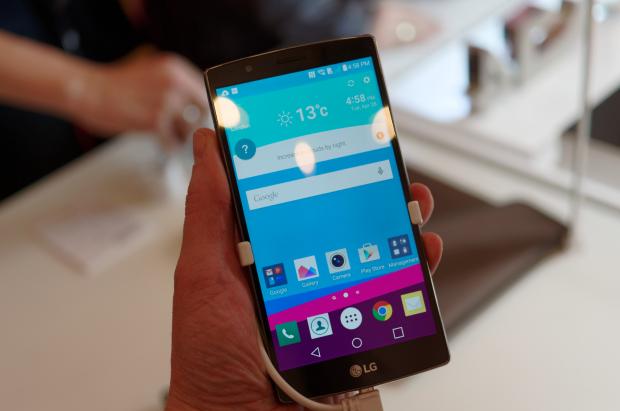
Those six cores are split in a dual-core/quad-core arrangement, running at frequencies of 1.8GHz and 1.44GHz respectively. On paper, and in testing, this delivers a mixed bag of results.
The results compare surprisingly well with the Snapdragon 810 in the HTC One M9, despite the fact that the G4 uses half the number of cores as the 810 for intensive tasks. It lags behind the Samsung’s Exynos 7420 processor, however, which is faster across the board, and it’s slower than both phones in the GFXBench gaming test. Do bear in mind, though, that the HTC One M9 has a lower resolution 1080p display which is far easier to drive than the G4's 1,440 x 2,560 screen.
Of the three big phones launched this year, then, the G4 is the slowest; that's not to say this is a problem, though. Indeed, the LG G4 feels perfectly responsive in daily use, and we haven’t yet found a game that fazes it.
Elsewhere, battery life is an improvement on last year’s G3, both in terms of its capacity and according to the results from our tests. Streaming a 720p video in flight mode with the screen set to a brightness of 120cd/m2 drained it at 6.3% per hour while audio streaming over 4G drained it at 3.6%.
That can’t quite match the Samsung Galaxy S6’s figures of 5.5% and 3%, but it's better than the MTC One M9 (9.7% and 2.6%), and with a user-replaceable battery, it's more flexible than both.
LG credits the phone’s improved efficiency to a number of changes, not least a more efficient screen. The G4 uses what LG calls “N-type liquid crystals”, which it says allows the light from the screen’s backlight through the structure of the liquid crystal more easily.
Reading between the lines, the benefit here isn’t intended to be extra brightness - the LG G4’s top brightness of 476cd/m2 is far from most eye-searing we’ve measured - rather the reduction the amount of power needed to power the display to that sort of brightness in the first place.
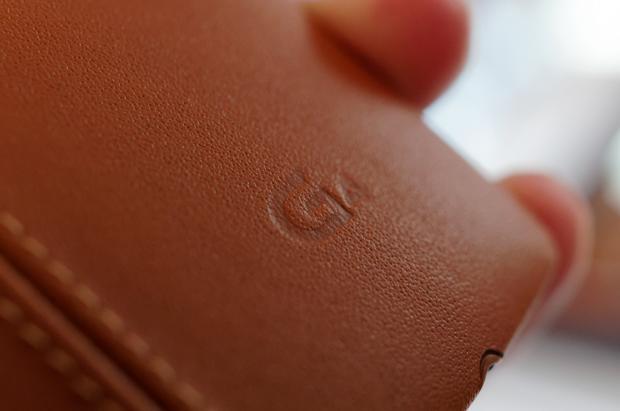
One of LG’s other claims is that the screen is capable of producing a wider range of colours than other phones, in accordance with the DCI (digital cinema initiatives) standard, rather than sRGB or Adobe RGB. In practice, we found the G4 covers 97.9% of the sRGB colour gamut, which is highly impressive in itself, while producing a richer tapestry of greens and reds.
Colour accuracy, however, is tougher to assess, since even with the automatic brightness adjustment turned off, the display still adjusts the intensity of the backlight depending on what’s displayed onscreen. To the eye, though, the LG G4’s display has plenty of impact, is as crisp as anyone needs, and the colours really leap from the screen.
LG G4 review: cameras
Smartphone cameras have been really moving on of late, and LG appears to be keeping pace here, upping the resolution to 16-megapixels from the G3's 13-megapixels, and the aperture to f/1.8, outdoing the f/1.9 aperture on the Samsung Galaxy S6’s rear camera in the process.
What this boils down to is there’s more light hitting the sensor. More light means you can use faster shutter speeds and/or lower ISO sensitivity settings. And that means sharper pictures that are lower in noise.
and/or lower ISO sensitivity settings. And that means sharper pictures that are lower in noise.

LG doesn’t stop there, though. It has also improved the optical image stabilisation system as well, adding “Z-axis feedback” this time around and the laser-assisted autofocus remains in place from the G3, helping the camera produce sharp photos quickly, not to mention a new "colour spectrum sensor”, which is used to set white balance and flash temperature correctly.
With near identical core specifications to the Samsung Galaxy S6 and S6 Edge's camera (16MP, f/1.9, 1/2.6in sensor, OIS, phase detect autofocus), the G4 ought to deliver a decent quality snap, and that it certainly does. In daylight, photos are crisp and well-exposed - the autofocus system really helps when shooting from the hip, and in terms of general quality it’s a match of the Samsung phone.
In low light the G4’s camera beats the S6’s in some respects, delivering a sharper, less noisy image, but in testing the LG didn’t always choose the correct white balance. Under fluorescent strip lights, for instance, white and light grey shades were tinged with yellow. So much for the colour spectrum sensor.
If you use the phone’s impressive manual mode, however, and set the G4 to shoot in raw (DNG format) and JPEG, you’ll be able to rescue those images, as well as maintain fine control over shutter speed, white balance, ISO sensitivity, exposure compensation and focus. There’s even an auto-exposure lock facility. It’s just a pity that LG doesn’t extend this level of control to video capture, which remains auto-only.

The front camera, as is the current trend, is now a high-resolution 8-megapixel unit, and there’s a host of enhancements to the camera software. You can now double tap the power button when the phone is in standby to launch the camera quickly.
There’s also a rather gimmicky, fairly pointless “gesture interval shot” selfie mode, which, simply put, lets you take a sequence of shots two seconds apart by opening your hand and clenching your fist in front of the camera a couple of times.
Naturally, there’s also the usual raft of improvements to LG’s UI overlay, which runs on a base of Android 5.1, but none appear to be particularly groundbreaking. Owners of new-ish Volkswagens, will appreciate the addition of support for its MirrorLink entertainment and navigation system , and you also get 100GB of Google Drive space, free for two years.
, and you also get 100GB of Google Drive space, free for two years.
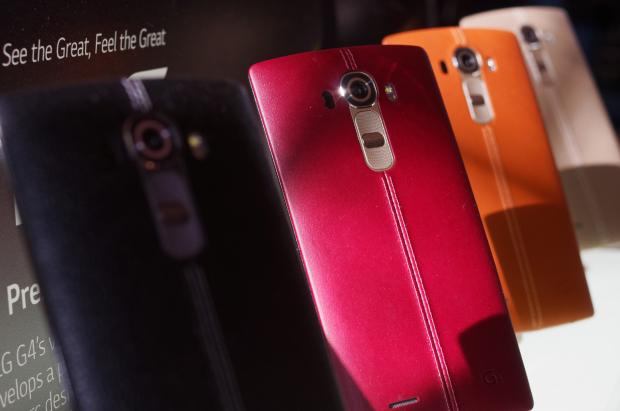
It’s hard to be different in the smartphone world, but LG has pulled it off with its attractive leather-backed G4 flagship.
Critically, it hasn’t compromised on performance, battery life or camera quality, and by retaining both a microSD slot and a removable battery, the G4 will appeal to a whole tranche of customers to whom flexibility is most important.
It’s too early to give the LG G4 a rating just yet because there are no prices for the leather options yet nor contract prices for any G4. The only price right now is for the plastic, SIM-free G4 from Amazon, which is £530.
However, assuming the leather phone comes in £30 to £50 more expensive, it’s still cheaper than a Samsung Galaxy S6, and that may yet tip the balance in the LG G4’s favour.
Of all the leading smartphones launched in 2015, the LG G4 is the only one with both a microSD card and a removable battery.
The LG G4’s design, certainly in terms of its basic shape and the placement of the controls, breaks no new ground. The rear is still gently curved and fits in your hand nicely. The volume and power buttons still reside in the centre of the rear panel, just below the camera
The overall dimensions haven’t changed much either. The LG G4 is slightly taller and slightly wider than the G3 at 149 x 75 x 8.9mm, but these are not differences you’ll notice with the naked eye.
Turn it on its side, however, and the changes begin to reveal themselves. First, the G4 sports a “Slim Arc” screen that gently curves from top to bottom, a bit like LG's G Flex models, but the curve isn’t quite so extreme.
The most dramatic new ‘feature’ introduced by LG, perhaps inspired by the Motorola Moto X (2014), is to the materials used in the design. You will, perhaps, have already seen the brown, leather-backed edition in the teaser material released by the company.
Well, that’s a standard (albeit premium) finish on the G4, and it isn’t just available in brown. There’s a whole range of different colours, all of which look very fetching, with precise, close stitching running down the centre and the G4 logo debossed into the leather in the bottom right corner.
There's even differentiation in the type of leather used, depending on the colour, with a smooth, close-grained briefcase finish on the brown and burgundy versions, and a coarser more open grained leather used on the pale blue, black, and light tan models.
The LG G4 also comes, slightly less interestingly, in plastic in a fetching range of shades including a glossy, "ceramic" white and titanium grey, with a subtle diamond pattern moulded into the shell.
We suspect most people choosing an LG G4 will go for the leather finish, which feels very nice indeed in the hand and looks great; the black version in particular is fabulous.
It wouldn't be a flagship launch without a specifications bump, so it's hardly a surprise to see an improvement on that front. But at least LG is doing things differently from the majority of the competition, utilising Qualcomm's six-core, 64-bit 1.8GHz Snapdragon 808 SoC, which is backed by an Adreno 418 GPU, 3GB of RAM and 32GB of storage.
Other specs include dual-band, dual-stream 802.11ac Wi-Fi with support for MU-MIMO, Cat9 4G
Those six cores are split in a dual-core/quad-core arrangement, running at frequencies of 1.8GHz and 1.44GHz respectively. On paper, and in testing, this delivers a mixed bag of results.
Performance results
|
LG G4
|
Samsung Galaxy S6
|
HTC One M9
|
GeekBench 3 - single-core
|
1,134
|
1,485
|
838
|
GeekBench 3 - multi-core
|
3,501
|
5,282
|
3,677
|
GFXBench 3.1 - T-Rex HD (onscreen)
|
25fps
|
38fps
|
49fps
|
GFXBench 3.1 - Manhattan (onscreen)
|
9fps
|
15fps
|
20fps
|
The results compare surprisingly well with the Snapdragon 810 in the HTC One M9, despite the fact that the G4 uses half the number of cores as the 810 for intensive tasks. It lags behind the Samsung’s Exynos 7420 processor, however, which is faster across the board, and it’s slower than both phones in the GFXBench gaming test. Do bear in mind, though, that the HTC One M9 has a lower resolution 1080p display which is far easier to drive than the G4's 1,440 x 2,560 screen.
Of the three big phones launched this year, then, the G4 is the slowest; that's not to say this is a problem, though. Indeed, the LG G4 feels perfectly responsive in daily use, and we haven’t yet found a game that fazes it.
Elsewhere, battery life is an improvement on last year’s G3, both in terms of its capacity and according to the results from our tests. Streaming a 720p video in flight mode with the screen set to a brightness of 120cd/m2 drained it at 6.3% per hour while audio streaming over 4G drained it at 3.6%.
That can’t quite match the Samsung Galaxy S6’s figures of 5.5% and 3%, but it's better than the MTC One M9 (9.7% and 2.6%), and with a user-replaceable battery, it's more flexible than both.
LG credits the phone’s improved efficiency to a number of changes, not least a more efficient screen. The G4 uses what LG calls “N-type liquid crystals”, which it says allows the light from the screen’s backlight through the structure of the liquid crystal more easily.
Reading between the lines, the benefit here isn’t intended to be extra brightness - the LG G4’s top brightness of 476cd/m2 is far from most eye-searing we’ve measured - rather the reduction the amount of power needed to power the display to that sort of brightness in the first place.
One of LG’s other claims is that the screen is capable of producing a wider range of colours than other phones, in accordance with the DCI (digital cinema initiatives) standard, rather than sRGB or Adobe RGB. In practice, we found the G4 covers 97.9% of the sRGB colour gamut, which is highly impressive in itself, while producing a richer tapestry of greens and reds.
Colour accuracy, however, is tougher to assess, since even with the automatic brightness adjustment turned off, the display still adjusts the intensity of the backlight depending on what’s displayed onscreen. To the eye, though, the LG G4’s display has plenty of impact, is as crisp as anyone needs, and the colours really leap from the screen.
LG G4 review: cameras
Smartphone cameras have been really moving on of late, and LG appears to be keeping pace here, upping the resolution to 16-megapixels from the G3's 13-megapixels, and the aperture to f/1.8, outdoing the f/1.9 aperture on the Samsung Galaxy S6’s rear camera in the process.
What this boils down to is there’s more light hitting the sensor. More light means you can use faster shutter speeds
LG doesn’t stop there, though. It has also improved the optical image stabilisation system as well, adding “Z-axis feedback” this time around and the laser-assisted autofocus remains in place from the G3, helping the camera produce sharp photos quickly, not to mention a new "colour spectrum sensor”, which is used to set white balance and flash temperature correctly.
With near identical core specifications to the Samsung Galaxy S6 and S6 Edge's camera (16MP, f/1.9, 1/2.6in sensor, OIS, phase detect autofocus), the G4 ought to deliver a decent quality snap, and that it certainly does. In daylight, photos are crisp and well-exposed - the autofocus system really helps when shooting from the hip, and in terms of general quality it’s a match of the Samsung phone.
In low light the G4’s camera beats the S6’s in some respects, delivering a sharper, less noisy image, but in testing the LG didn’t always choose the correct white balance. Under fluorescent strip lights, for instance, white and light grey shades were tinged with yellow. So much for the colour spectrum sensor.
If you use the phone’s impressive manual mode, however, and set the G4 to shoot in raw (DNG format) and JPEG, you’ll be able to rescue those images, as well as maintain fine control over shutter speed, white balance, ISO sensitivity, exposure compensation and focus. There’s even an auto-exposure lock facility. It’s just a pity that LG doesn’t extend this level of control to video capture, which remains auto-only.
The front camera, as is the current trend, is now a high-resolution 8-megapixel unit, and there’s a host of enhancements to the camera software. You can now double tap the power button when the phone is in standby to launch the camera quickly.
There’s also a rather gimmicky, fairly pointless “gesture interval shot” selfie mode, which, simply put, lets you take a sequence of shots two seconds apart by opening your hand and clenching your fist in front of the camera a couple of times.
Naturally, there’s also the usual raft of improvements to LG’s UI overlay, which runs on a base of Android 5.1, but none appear to be particularly groundbreaking. Owners of new-ish Volkswagens, will appreciate the addition of support for its MirrorLink entertainment and navigation system
It’s hard to be different in the smartphone world, but LG has pulled it off with its attractive leather-backed G4 flagship.
Critically, it hasn’t compromised on performance, battery life or camera quality, and by retaining both a microSD slot and a removable battery, the G4 will appeal to a whole tranche of customers to whom flexibility is most important.
It’s too early to give the LG G4 a rating just yet because there are no prices for the leather options yet nor contract prices for any G4. The only price right now is for the plastic, SIM-free G4 from Amazon, which is £530.
However, assuming the leather phone comes in £30 to £50 more expensive, it’s still cheaper than a Samsung Galaxy S6, and that may yet tip the balance in the LG G4’s favour.
LG G4 specifications | |
| Processor | Six-core (dual 1.8GHz and quad 1.44GHz), Qualcomm Snapdragon 808 |
| RAM | 3GB |
| Screen size | 5.5in |
| Screen resolution | 1,440 x 2560, 538ppi (Gorilla Glass 3) |
| Screen type | IPS |
| Front camera | 8MP |
| Rear camera | 16MP (f/1.8, phase detect autofocus, OIS, 1/2.6in sensor size) |
| Flash | Dual LED with colour spectrum sensor |
| GPS | Yes |
| Compass | Yes |
| Storage | 32GB |
| Memory card slot (supplied) | MicroSD |
| Wi-Fi | 802.11ac (2x2 MU-MIMO) |
| Bluetooth | Bluetooth 4.1 LE, A2DP, apt-X |
| NFC | Yes |
| Wireless data | 4G, Cat9 (450Mbits/sec download) |
| Size (WDH) | 75 x 8.9 x 149mm |
| Weight | 155g |
| Operating system | LG UX 4.0 (based on Android Lollipop 5.1) |
| Battery size | 3,000mAh |
Price and availability | |
| Availability | Not known yet |
| SIM-free price | Not known yet |
| Contract price | Not known yet |

No comments:
Post a Comment